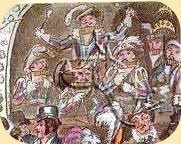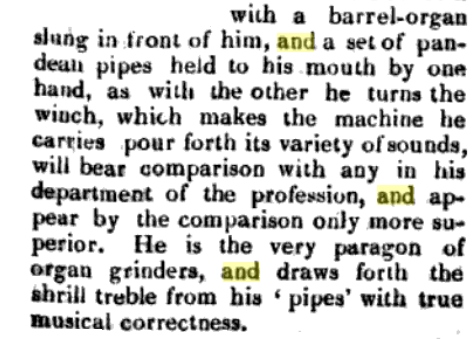The Regency Pan-pipe and Tabor: 1790 - 1820
Pandean pipes history
the beginning
by Frances
Both women and men are shown in contemporary illustrations playing the pan-pipes; the drum is played either horizontally or vertically. Pan-pipes were known as pandean pipes or mouth-organ at this time.
Theatre variety artists used pan-pipes in their acts so that they would have their other hand free to do something else spectacular. In 1813 a grand concert was held in a theatre in Newcastle at which an Italian gentleman, Signor Rivolta, "exhibited his wonderful performance" on the pandean pipes, tabor, Spanish guitar, triangle, harmonica, Chinese crescent, cymbals and bass drum. The records do not show whether he played them all at once. However in 1820 at the Peale Museum in Philadelphia, USA, when 'Signor Helene and his Pandean Band' performed he did play on his 5 different instruments at the same time. These included the Italian viola, Pandean pipes, Chinese bells, Turkish cymbals, and tenor drum; during performances he also imitated a mockingbird and a canary with his voice.'Building Little Italy, Philadelphia's Italians before Mass Migration' by Richard N. page 70, Juliani Pennsylvania State University Press, ISBN: 9780271017327. A set of pan pipes dated to the late 18th century is in the Science Museum.
The panpipe and drum player was loud, which was useful at outdoor events such as fairs, races, street processions and celebrations. A painting entitled 'Sweeps Day in Upper Lisson Street, Paddington' painted in the late 1830's shows a 'Jack-in-the-Green' with other historically-based characters dancing to the pan-pipes and tabor in the street. (Museum of London Collection). So there is the possibility that the piper 'who also played the drum' as remembered by an elderly gentleman in 1860 recalling a "Jack in Green" procession of his childhood may have played the panpipes too. source
The instruments found their way into contemporary literature.
" having inherited the musical taste and talents of his father, he has bitten the whole school with the mania.
He is a great hand at beating a drum, which is often heard rumbling from the rear of the school-house. He is teaching half the boys of the village, also, to play the fife, and the pandean pipes; and they weary the whole neighbourhood with their vague piping, as they sit perched on stiles, or loitering about the barn-doors in the evenings."1819, 'Bracebridge Hall or The Humorists' by Washington Irving [pseudonym Geoffrey Crayon] (1783-1859), American essayist, historian, and author who spent some years doing the Grand Tour in Europe.
Panpipe and tabor were often played at local fairs. In 1819 a man was beaten up and robbed at a fair in Hampstead, London. Henry Lovell, one of the fair workers, was blamed. His written defence was:
"the prosecutor came into the booth, and said I had robbed him, which I deny. There were hundreds of people there, some of whom got me into a crowd, and stole my mouth-organ and drum."
sourceIn New Zealand in 1827 at the crowded Sandy Bay races on New Year's Day
"the notes of the rustic Pandean pipe and drum mixed with those of the more jocund fiddle"
Colonial Times and Tasmanian Advertiser, Friday 5th January 1827An Irish painting, 'The Gypsy Caravan' by William Mulready (1786 - 1863), depicts a rural scene with a poor man playing the panpipes and drum, with a tambourine balanced on top.
Some London street entertainers earned their living playing pan-pipes and drum in the streets, often in conjunction with puppet booths or Punch and Judy shows. Henry Mayhew (1812 - 1887) a social researcher, journalist, playwright and advocate of reform published 'London Labour and the London Poor' in 1851. This was a groundbreaking and influential survey of the poor of London. Mayhew interviewed many street entertainers including a 'street musicianer', a performer on 'drum and pipes', who recounted what he did some 30 years before.
"I have played the pandean pipes and the drum for thirty years to street exhibitions of all kinds. I married a young woman that I fell in love with, in the music line. She played a hurdy-gurdy in the streets, so I bought pandean pipes,
as I was always fond of practising music, and I joined her. Times for street-musicianers were good then, but I was foolish. I 'm aware of that now;
but I wasn't particularly partial to hard work; besides, I could make more as a street-musicianer.
When I first started, my wife and I joined a fantoccini. [puppet theatre] It did well. My wife and I made from 9s. to 10s. a-day.
sourceA street puppet theatre came along the road in 1825:
"Its coming was announced by a man playing the Pan-pipes, or "mouth-organ," which he accompanied by beating the long drum;
after him followed the theatre, consisting of a square frame-work about ten feet high, ...
The band of two instruments was set in motion by its performer, who took his station on one side, and the carrier of the theatre assuming the important office of money collector....
Boys came running in from the fields, women with children got "good places," windows were thrown up and well filled, the drummer beat and blew away lustily, the audience increased every minute, .......
In about a minute the tune altered, and the show began".This description is accompanied by a drawing of a pupper booth.
An 1828 sketch shows the characters in Punch and Judy, together with the pandean pipes and drum player 'bottler' standing outside the booth.
(source: frontispiece in 'The Tragical Comedy or Comical Tragedy of Punch and Judy' by George Cruickshank)A dancing bear was reported on Tuesday Aug 15th 1809 as being accompanied by panpipes and tabor:
"A week Wednesday senight there did with drum and panpipes parade publickly the streets of this town two mountebanks leading by the chain a monster brown bruin."
from: 'The Evolution of an English Town Being the story of the ancient town of PICKERING in Yorkshire ', 1915, Dent, page 225As pandean pipes became more fashionable in the middle and upper classes, music books with arrangements especially for the pandean pipes were printed, such as 1810 'Third Book of Pandean Music.'
Dances and dance tunes were named after them: 1791 'Vauxhall Saloon. A Pandean Dance' 'The Pandean Dance or Lord Wellington' published in 'Hime's Dances for 1812'. New tunes had 'pandean' in the title, such as in 'The Joseph Kershaw Manuscript; the music of a 19th century Saddleworth Fiddle Player' (begun in 1820).
Often the word pandean is coupled with 'Tekeli' ( or Tekeli, Takele, Tekely, Tekeele). This was the title of an operatic work composed by James Hook (1746-1827) in 1806. Tekeli was a very popular tune which subsequently appeared in many musicians' manuscripts and published collections, for example Goulding's 'Twenty Four Country Dances for the Year 1808'. The same tune is called 'A Favourite Pandean Dance' in local manuscripts in Shropshire, Dorset and Sussex. Similar melodies are in the Hardy MSS under the title 'Pandean Dance in Tekeli', in the Welch MSS of 1800 and the dance occurs in 1809 in 'Wilson's Treasures of Terpsichore'. The tune survived as a merry-go-round tune at Southport Fairground until Victorian days.
Panpipe and drum were often part of a small band. An engraving of the 1814 Thames Frost Fair shows a couple dancing to a group of musicians that include a pan-pipes and drum player. (also printed in the 'Illustrated London News' of 21 December 1844). Whole pandean bands were soon all the rage at fashionable places of entertainment in which every band member played the panpipes and a percussion instrument. The pandean band at Vauxhall Gardens, London, is recorded as playing in 1804, 1818-19, 1822, 1824 and in 1825. The ensemble's repertoire included marches, quick-steps, minuets, waltzes, and airs.( The Encyclopaedia of Musical Instruments, (ed. R Dearling, 1996), has a drawing of a Pandean band playing at Vauxhall Gardens in 1806.At Ranelagh Gardens, another London outdoor pleasure garden, Natalie Corrie was the composer for the Pandean Band around 1810-1815.
The vogue for pandean bands had spread from the military to civilian life from the late eighteenth-century to the end of Regency times. The percussion instruments played in these bands were thought of as giving a fashionable 'Turkish' flavour to the music. The Ottoman Empire had invaded Europe and the military leaders (the princes) were very impressed by the clamour of the loud percussion instruments that led Turkish armies into battle. They had trumpets, drums, cymbals and loud bells and triangles. When the Sultan of Turkey was defeated in battle he made a present of a band of military musicians to the winner, the King of Poland. So of course, every war-like monarch with an eye to his military reputation had to have a loud band too. 'Turkish' instruments quickly became standard for military bands across Europe.
The Turkish Band, with panpipe and drum player, entertain in a print dated 1821: 'Tom and Jerry Larking at a Masquerade Supper', by George Cruikshank (1792 - 1878). James Saggiani's household accounts, Gloucestershire, include "pan pipes for the regiment" (Gloucestershire Archives item D2700/RA2/1/21 1798-1801). A one-man band wearing military uniform includes the pandean pipes (illustrated online Bridgeman Art Library, item no. 249560).
top of page

